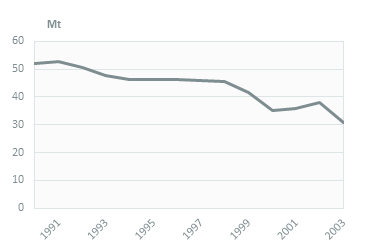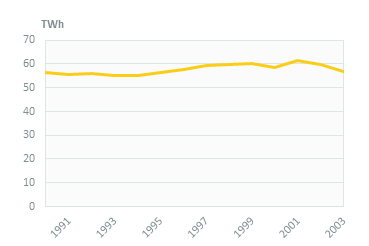-
-
 Energy and Climate Databases
Energy and Climate Databases- The most comprehensive and up-to-date annual energy database.
- Monitoring of technology providers in H2 supply chain.
- Monthly energy data on key energy markets.
- The most reliable and up-to-date power generation database.
- The essentials of LNG trade at your fingertips.
- Global monitoring of new and existing refineries.
- Analyse energy consumption and efficiency trends at world level. Benchmark countries.
- Have your database developed by a recognised expert of both energy and IT.
-
 Energy - Climate Forecasts
Energy - Climate Forecasts- Instant access to energy and emissions forecasts.
- Strategic, annual wholesale price projections backed by Enerdata's energy modelling expertise and our globally recognised POLES model.
- Wedges module showing a breakdown of the levers enabling to reduce emissions between two scenarios.
- Unique, independent projections of consumption by end-use.
- GHG Marginal Abatement Cost Curves.
- Benefit from proven models to draw your own energy scenarios and anticipate tomorrow’s challenges.
-
 Market Intelligence
Market Intelligence- 110 Energy and climate country reports
- A newsletter to receive the latest updates on evolving technologies and policies.
- Global energy news and analyses curated daily.
- Enerdata’s experts bring you the essentials about your market and competitors.
-
-
-
 Market Analysis
Market Analysis- Understanding key consumption trends and drivers across sectors.
- Granular and exclusive insight to address the most pressing business and strategic issues.
- Expertise in strategic and business intelligence, with fine-tuning to the market’s specificities.
-
 Energy - Climate Scenarios
Energy - Climate Scenarios- Providing the outlook of an energy commodity in mid to long term time horizons.
- Sector and driver specific energy demand forecasting.
- Assess the evolution of energy prices on the international and regional markets, as well as end-users prices.
- Enerdata guides you through pathways to reach climate targets.
- Supporting local authorities in their decarbonisation strategies.
-
 Climate Strategy and Policy Evaluation
Climate Strategy and Policy Evaluation- Cutting-edge quantitative tools and relevant indicators to monitor and evaluate evolutions on worldwide energy markets.
- Analysis of the most cost-effective options to reduce emissions.
- Quantified simulation and analysis of pledges for climate change negotiations.
- Breakdown and analysis of carbon markets.
- Enerdata guides you on the most beneficial policy or investment options.
- Turning climate objectives into concrete action plans.
-
 Training
Training- Understand different policy targets and measures on energy efficiency.
- How to measure energy savings?
- Energy Forecasting is a 2 days training to learn to design and interpret energy forecasts.
- Energy statistics training allowing to create energy balance with supply, transformation and consumption and understanding the international energy statistics regulations.
- Initiation to EnerMED level 1is the training to approach on the most powerful energy demand forecasting model.
-
-
Resource Centre
Czechia Key Figures
- Population:
- 10.5 million
- GDP growth rate:
- -0.4 %/year
- Energy independence:
- 60.4%
Data of the last year available: 2023
- Total consumption/GDP:*
- 61.3 (2005=100)
- CO2 Emissions:
- 7.73 tCO2/capita
- Rate of T&D power losses:
- 5.04%
* at purchasing power parity
View all macro and energy indicators in the Czechia energy report
Czechia Related News
View all news, archive your new and create your own daily newsletters only on your topics/countries of interest with Key Energy Intelligence
Czechia Related Research
Benefit from up to 2 000 up-to-date data series for 186 countries in Global Energy & CO2 data
A data overview is available in the global energy statistics app
Total Energy Consumption
Energy consumption per capita is 33% higher than the EU average (3.7 toe in 2023), whereas electricity consumption per capita is 0.2% higher than the EU average, at around 5 370 kWh/capita in 2023.
In 2023, energy consumption decreased by 6% to 39 Mtoe after an increase by 6% in 2021 and a small reduction in 2022 (-2%). The energy consumption in 2023 is 9% lower than in 2019. Total energy consumption declined by an average of 1.1%/year between 2006 and 2016 to 41 Moe and remained roughly stable until 2019.
Interactive Chart Czechia Total Energy Consumption
Benefit from up to 2 000 up-to-date data series for 186 countries in Global Energy & CO2 data
View the detailed fondamentals of the market at country level (graphs, tables, analysis) in the Czechia energy report
Crude Oil Production
In 2023, the country imported 7.4 Mt of crude oil (-0.4% on 2022); 37% of crude oil imports came from Russia (31% in 2021), 21% from Germany, and 15% from Azerbaijan (2022).
Oil is imported from Russia through the Druzhba pipeline ("Friendship") and from Germany through the IKL pipeline connected to the transalpine pipe (TAL) in Ingolstadt.
The refining capacity is spread over 2 refineries, namely Litvinov (108.5 kb/d) and Kralupy (67.7 kb/d); the 20 kb/d Pardubice refinery ceased operations in 2012. It fell by 44% in 1994 from 310 kb/d to 175 kb/d.
Interactive Chart Czechia Crude Oil Production
Benefit from up to 2 000 up-to-date data series for 186 countries in Global Energy & CO2 data
Additionally, for more detailed information on refineries, you can request a sample of our EMEA Refineries Dataset
Oil Products Consumption
Oil product consumption dropped by 3% in 2023 to 9 Mt after two years of increase (+10% in 2021 and +3% in 2022). Oil product consumption, which had been declining by 2.6%/year between 2008 and 2016, recovered in 2017 (+18%) and stabilised at around 9.3 Mt until 2019, before dropping by 10% in 2020 with transport restrictions.
Around 2/3 of oil is consumed by transport (69% in 2023). The share of transport has surged since 2000 (49%), as the number of cars rose by more than 50%. Industry accounted for 23% of oil consumption in 2022 (mainly non-energy uses).
Interactive Chart Czechia Refined Oil Products Production
Benefit from up to 2 000 up-to-date data series for 186 countries in Global Energy & CO2 data
Additionally, for more detailed information on refineries, you can request a sample of our EMEA Refineries Dataset
Natural Gas Consumption
Natural gas consumption dropped considerably in 2023 and 2022 (-10% and -20%) due to the consequences of the war in Ukraine and the significant increase in gas prices, reaching 6.8 bcm in 2023. The drop was especially dramatic for power plants, with a 42% reduction in natural gas consumption in 2022 followed by a 12% reduction in 2023. Residential and services reduced their gas consumption by 12% and 18% respectively in 2023 and 2022 to 2.8 bcm. Consumption increased by 1%/year between 2016 and 2021 to 9.5 bcm.
Graph: NATURAL GAS CONSUMPTION (bcm)
Interactive Chart Czechia Natural Gas Domestic Consumption
Benefit from up to 2 000 up-to-date data series for 186 countries in Global Energy & CO2 data
Additionally, for more detailed information on the LNG trade, you can request a sample of our EMEA LNG Trade Dataset
Coal Consumption
After the rebound in 2022 (+6%), coal and lignite consumption dropped by 15% in 2023 to 30 Mt. It followed a downward trend from 2000 to 2020 (-1.7%/year between 2000 and 2018, -12%/year on average between 2018 to 2020). Lignite accounts for 91% of this consumption.
Graph: COAL AND LIGNITE CONSUMPTION (Mt)

Most of the coal and lignite is consumed by the power sector (86% in 2023).
Graph: COAL AND LIGNITE CONSUMPTION BREAKDOWN BY SECTOR (2023, %)
Interactive Chart Czechia Coal and Lignite Domestic Consumption
Benefit from up to 2 000 up-to-date data series for 186 countries in Global Energy & CO2 data
View the detailed consumption trends at country level (graphs, tables, analysis) in the Czechia energy report
Power Consumption
After peaking at 61 TWh in 2021, electricity consumption decreased by 2% in 2022 and by 5% in 2023 to 57 TWh due to rising prices. In particular electricity consumption for residential and services decreased by 4% in 2023 (-9% in 2022), compared to -6% for industry. Electricity consumption remained stable between 2017 and 2019 at around 60 TWh, before dropping by 2.7% in 2020. It grew by 2.4%/year between 2014 and 2017.
Graph: ELECTRICITY CONSUMPTION (TWh)

Renewable in % Electricity Production
The new draft NECP (2023) aims to raise the share of renewables in final energy consumption to 30% in 2030, including 30.7% in heating and cooling, 35% in electricity, and 25% in transport. The target set for 2020 of 13.5% of renewables in final energy consumption has been exceeded by almost 4 points (17.3%). In 2022, this share reached 18.2%, of which 15.5% is for electricity, 25.8% for heating and cooling, and 7.2% for transport).
Interactive Chart Czechia Share of Renewables in Electricity Production (incl hydro)
Benefit from up to 2 000 up-to-date data series for 186 countries in Global Energy & CO2 data
Learn more about renewables in the European Battery Market Analysis
CO2 Fuel Combustion/CO2 Emissions
Total net GHG emissions increased by 1% in 2022 to 124 MteqCO2 and were 37% below their 1990 level. GHG emissions have been increasing by 1.8%/year between 2014 and 2019 and dropped by 5% in 2020.